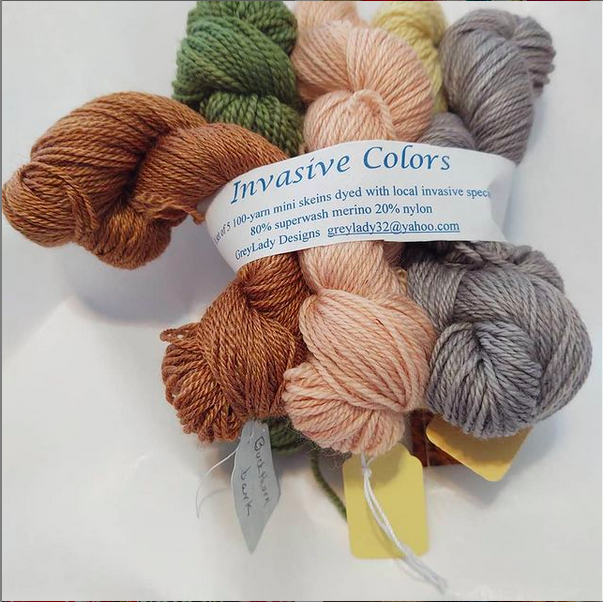Thanks for the engaged comments on yesterday's post about the natural plant dyes class I took, friends!
I want to respond to a couple points, since I'm entirely new to this and enjoying the learning.
I'd never dyed with plants before.
I was amazed
how variable dyes are, depending on how they're prepared... plus other variables, like the mineral content of your water, what
pot you dye in; what fabric you dye, etc.
As the teacher, Theresa, said, "Living things are unpredictable."
No kidding.
River commented she'd thought hollyhock would dye pink, not blue-grey. I was surprised, too, that the color of the plant itself does not determine the color of its dye. (Though the hollyhock was a purple black, so losing the red isn't too unlikely.)
GZ replied that the color can be changed or intensified with different mordants (fixatives, such as alum) and/or different modifiers (e.g. mineral waters colored by soaking iron, copper soaked in it).
We saw that in class.
Die, Invasive Species, Dye!
Here's buckthorn--an invasive species everyone hates because it's hell to remove, and it keeps coming back (Minnesota DNR page on managing buckthorn).
But it's a great dye plant.
Below: For this dye batch, buckthorn bark was simmered in hot water, like tea, making a foxy-color (bottom left).
Then iron water was added to some of the stuff, like what Penny Cooper is holding, bringing out the gold:
Below: Also buckthorn––but the bark was soaked in 50/50 ammonia and water. (No heat.)
Same plant, but it dyes pink!
Theresa is a retired chemistry teacher. She teaches classes on dyeing with local invasive species. She encourages it because everyone wants to kill these plants--they are the opposite of endangered.
She sells Invasive Colors yarn too, at markets in Duluth.
"It's amazing what you can get from nasty plants," she says.
Salvaging vs Foraging
Lichen is the opposite of invasive--it is very fragile.
Joanne was concerned that the teacher used lichen dye, even with lichen taken from dead trees. She commented :
"Left on the fallen tree, the lichen would have aided its decomposition. In my estimation, lichen is too fragile to be harvested, ever. I used to spin wool, dye it and sell it, and I never took lichen. It takes too, too, too many years to grow.Yes!
Some colors are not worth the cost."
This is important, so I want to clarify what Theresa told us.
She lives in the area of the Duluth Folk School and has contacts to alert her to salvage projects for endangered plants.
When road crews are coming through forest, cutting down trees or breaking up rock, and and hauling it all away, she goes in and salvages lichen that would not be left in a natural environment.
That's different than foraging for plants in the wild.
Theresa said many dyers will not work with lichen, even salvaged, because it alerts other people to its wonderfulness who then might forage lichen from the wild.
So, using lichen is something of an ethical quandary.
Does it encourage people to be more aware and appreciative of lichen, and thus to be more likely to protect it and its environment?
That's the effect it has on me.
I was deeply grateful to get to work with this crazy life form.
Or, does it give license to people who don't give a hoot?
Yeah, I can see how that could happen too.
Working with living beings... We are unpredictable.
Gotta weigh the probabilities and the costs, and make your choice.




Oh my these are all so lovely! Brilliant that you are doing this- teach me- someday! Beautiful colors and surprises and exclamations "how can that be!" Plants!!
ReplyDeleteLINDA SUE: Oooh, it'd be so fun to come play in your garden and with your local plants:
ReplyDeleteI bet you have a big bonanza of dye plants!
The teacher was so encouraging to just play with plants.
Here's what she said--it's kinda like making tea.
(Of course some people are much more scientific about it, but,
basically, you just:
1. chop up some plant material--roots, leaves, flowers, bark
(***wear gloves if you don't know if they have toxins),
Of course some won't dye, or the color won't last.
So you can look them up, or just try 'em out.
I'm going to behead the marigolds today and simply soak them in the hot sun for a couple days---like sun tea!
2. Simmer plant stuff in water on very low heat for a while, until you can see color.
3. Wash some wool in dish soap, (animals fibers take dye better than plant fibers do),
drop it in the dye bath,
4. sprinkle in some alum (a tablespoon---she didn't measure anything, which I love)
(alum is a "mordant"--a fixative you can buy in weak form in the grocery store--it's for pickling),
5. Stir,
and let it soak until it turns a color!
Pull out and let dry.
I know there's more fancy tricks to it, but that's the basics!
P.S. Frex = Fresca
ReplyDeleteI now know more about dyeing than I ever did. The only thing I ever dyed was my hair when I was younger and that stuff is all chemicals. I don't think I have ever seen alum in the shops here, not a lot of people do their own pickling or dying where I am.
ReplyDeleteRIVER: Alum here is in the spice dept.
ReplyDeleteYou can order it online if you're interested. I looked it up, and you definitely do need some mordant--alum or something else--for the dye to stick--otherwise it just washes out.